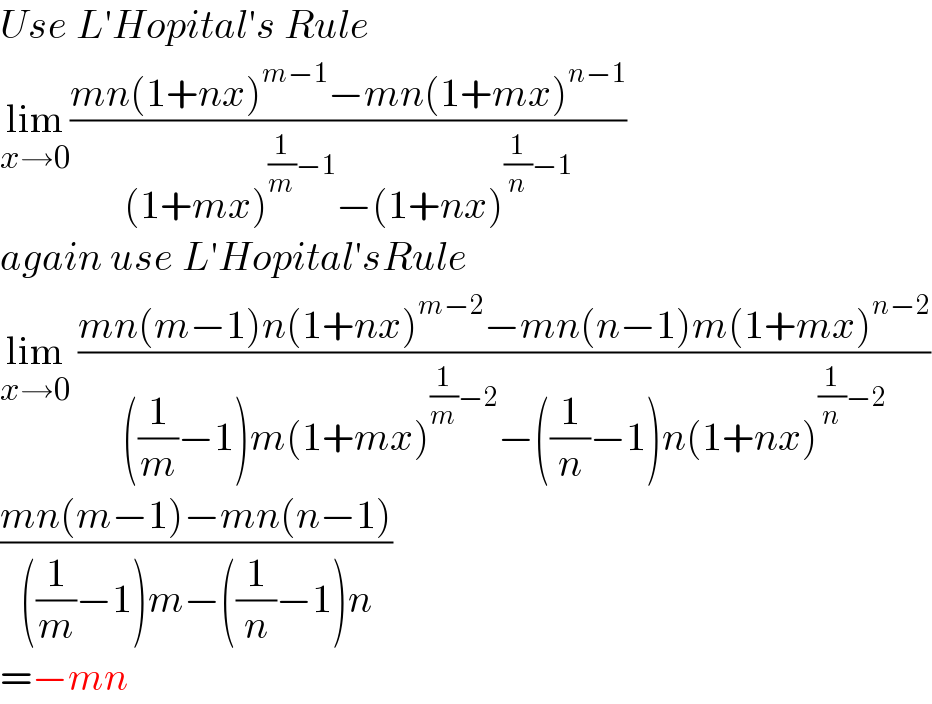
Question Number 211917 by Spillover last updated on 24/Sep/24

Answered by BHOOPENDRA last updated on 24/Sep/24

$${Use}\:{L}'{Hopital}'{s}\:{Rule}\: \\ $$$$\underset{{x}\rightarrow\mathrm{0}} {\mathrm{lim}}\frac{{mn}\left(\mathrm{1}+{nx}\right)^{{m}−\mathrm{1}} −{mn}\left(\mathrm{1}+{mx}\right)^{{n}−\mathrm{1}} }{\left(\mathrm{1}+{mx}\right)^{\frac{\mathrm{1}}{{m}}−\mathrm{1}} −\left(\mathrm{1}+{nx}\right)^{\frac{\mathrm{1}}{{n}}−\mathrm{1}} } \\ $$$${again}\:{use}\:{L}'{Hopital}'{sRule} \\ $$$$\underset{{x}\rightarrow\mathrm{0}} {\mathrm{lim}}\:\frac{{mn}\left({m}−\mathrm{1}\right){n}\left(\mathrm{1}+{nx}\right)^{{m}−\mathrm{2}} −{mn}\left({n}−\mathrm{1}\right){m}\left(\mathrm{1}+{mx}\right)^{{n}−\mathrm{2}} }{\left(\frac{\mathrm{1}}{{m}}−\mathrm{1}\right){m}\left(\mathrm{1}+{mx}\right)^{\frac{\mathrm{1}}{{m}}−\mathrm{2}} −\left(\frac{\mathrm{1}}{{n}}−\mathrm{1}\right){n}\left(\mathrm{1}+{nx}\right)^{\frac{\mathrm{1}}{{n}}−\mathrm{2}} } \\ $$$$\frac{{mn}\left({m}−\mathrm{1}\right)−{mn}\left({n}−\mathrm{1}\right)}{\left(\frac{\mathrm{1}}{{m}}−\mathrm{1}\right){m}−\left(\frac{\mathrm{1}}{{n}}−\mathrm{1}\right){n}} \\ $$$$=−{mn} \\ $$
Commented by Spillover last updated on 24/Sep/24

$${great}.{thanks} \\ $$
Answered by BHOOPENDRA last updated on 24/Sep/24

$${method}\left({II}\right) \\ $$$$\left(\mathrm{1}+{nx}\right)^{{m}} =\mathrm{1}+{mnx}+{o}\left({x}^{\mathrm{2}} \right) \\ $$$$\left(\mathrm{1}+{mx}\right)^{{n}} =\mathrm{1}+{nmx}+{o}\left({x}^{\mathrm{2}} \right) \\ $$$${So}\: \\ $$$$\left(\mathrm{1}+{nx}\right)^{{m}} −\left(\mathrm{1}+{mx}\right)^{{n}} =\mathrm{0} \\ $$$${for}\:{second}\:{order}\:{term} \\ $$$$\left(\mathrm{1}+{nx}\right)^{{n}} =\mathrm{1}+{mnx}+\frac{{m}\left({m}−\mathrm{1}\right)}{\mathrm{2}}\left({nx}\right)^{\mathrm{2}} +{o}\left({x}^{\mathrm{3}} \right) \\ $$$$\left(\mathrm{1}+{mx}\right)^{{n}} =\mathrm{1}+{mnx}\:+\frac{{n}\left({n}−\mathrm{1}\right)}{\mathrm{2}}\left({mx}\right)^{\mathrm{2}} +{o}\left({x}^{\mathrm{3}} \right) \\ $$$$\left(\mathrm{1}+{nx}\right)^{{n}} −\left(\mathrm{1}+{mx}\right)^{{m}} =\frac{{m}\left({m}−\mathrm{1}\right)}{\mathrm{2}}\left({nx}\right)^{\mathrm{2}} −\frac{{n}\left({n}−\mathrm{1}\right)}{\mathrm{2}}\left({mx}\right)^{\mathrm{2}} \\ $$$${similarly}\:{do}\:{for}\:{denominator} \\ $$$$\underset{{x}\rightarrow\mathrm{0}} {\mathrm{lim}}\frac{\frac{{m}\left({m}−\mathrm{1}\right)}{\mathrm{2}}\left({nx}\right)^{\mathrm{2}} −\frac{{n}\left({n}−\mathrm{1}\right)}{\mathrm{2}}\left({mx}\right)^{\mathrm{2}} }{\frac{\left({m}−\mathrm{1}\right)}{\mathrm{2}{m}}\left({mx}\right)^{\mathrm{2}} −\frac{{n}\left({n}−\mathrm{1}\right)}{\mathrm{2}{n}}\left({nx}\right)^{\mathrm{2}} } \\ $$$$=−{mn} \\ $$
Commented by Spillover last updated on 24/Sep/24

$${thanks} \\ $$
